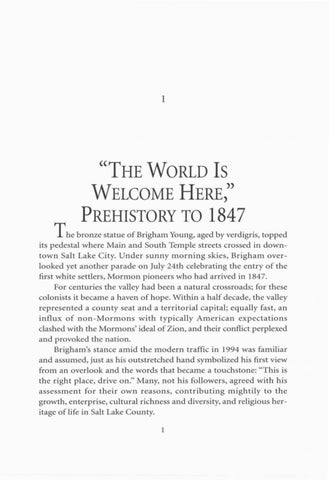T h e bronze statue of Brigham Young, aged by verdigris, topped its pedestal where Main and South Temple streets crossed in downtown Salt Lake City. Under sunny morning skies, Brigham overlooked yet another parade on July 24th celebrating the entry of the first white settlers, Mormon pioneers who had arrived in 1847. For centuries the valley had been a natural crossroads; for these colonists it became a haven of hope. Within a half decade, the valley represented a county seat and a territorial capital; equally fast, an influx of non-Mormons with typically American expectations clashed with the Mormons' ideal of Zion, and their conflict perplexed and provoked the nation. Brigham's stance amid the modern traffic in 1994 was familiar and assumed, just as his outstretched hand symbolized his first view from an overlook and the words that became a touchstone: "This is the right place, drive on." Many, not his followers, agreed with his assessment for their own reasons, contributing mightily to the growth, enterprise, cultural richness and diversity, and religious heritage of life in Salt Lake County.
Utah Centennial County History Series - Salt Lake County 1996

Issuu converts static files into: digital portfolios, online yearbooks, online catalogs, digital photo albums and more. Sign up and create your flipbook.













